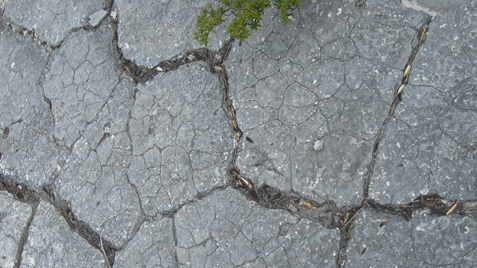

Sandy dune and beach deposits from Cat Island in the Bahamas show evidence of unusual polygonal cracks produced by the drying of naturally moist—but mud-free—ooid sand.
/ Published July 11, 2011
Smith College geologists, exploring an unusual type of sedimentary structure they call polygonal sandcracks, have discovered that these features can develop in a certain type of sand without the usual necessary ingredient—mud. They made their discovery in ancient (nearly 6,000 year-old) and modern calcium carbonate deposits on Alligator Point, Cat Island, Bahamas.
Until now, it was thought that these polygonal cracks form only in muddy sediment. But, in their research, a team of geosciences faculty and students found that these cracks can also form in mud-free sand composed of sphere-shaped carbonate grains called ooids.
Members of the research team include Bosiljka Glumac, associate professor of geosciences; H. Allen Curran, William R. Kenan Jr. Professor Emeritus of Geology; Sara Pruss, assistant professor of geosciences; Sarah Motti ’10 and Madeline Weigner ’09.
The presence of polygonal cracks indicates that the Bahamian sands were once moist but subsequently
exposed to the air and dried before being cemented into sandstone. The discovery of this
new sedimentary structure can help geoscientists constrain ancient environmental conditions
by differentiating ancient beach and dune sandstones from those that formed on the seafloor.
In addition, geoscientists can gain better insights into past climate and its fluctuating
moisture regimes, that is, its alternating wet and dry periods. Carbonate sandstones are
very important water and petroleum reservoirs. Discovery of polygonal cracks in carbonate
sandstones provides useful new information about generation and distribution of fractures
that can serve as storage and pathways for migration and extraction of precious liquids from
such rocks.
Physical properties that make moist sand sticky and allow it to crack during drying are related
to those that allow the building of sandcastles in moist sand and cause their collapse as
the sand dries. To better understand these processes, the authors consulted with Professor
of Physics Nalini Easwar, who studies granular media, and with Joyce Palmer-Fortune, a physics
lecturer and laboratory instructor whose students Ruobing Zhang ’13 and Jenn Chang ’12 used
a high-speed camera to film a sand-cracking experiment in the laboratory.
Their study is published in the July issue of the journal Geology.















